WHALES!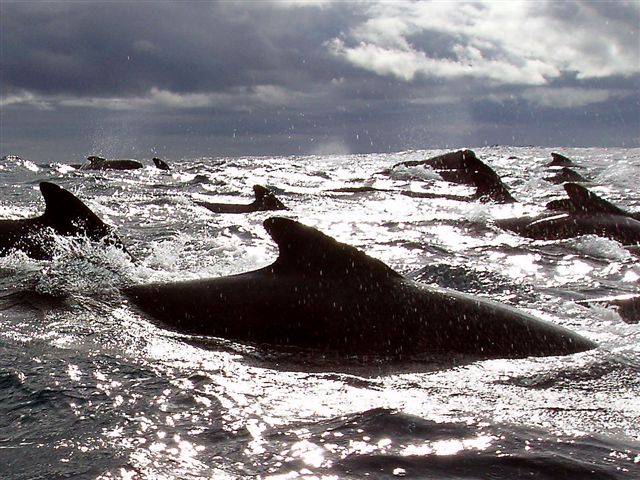 We were halfway between the Faroes and Iceland when they first appeared. We were going nowhere in a calm as flat as an ironing board. I had just finished my evening meal and was taking a short nap. A few explosive snorts and splashes broke into my reverie and brought me to the hatch. Five or six black fins broke the surface nearby. Dolphins! The first we had seen since a short visit of ten or so somewhere east of the Humber. We all love them, don't we? Their power. Their joie de vivre. I ducked back below for my little video camera. Maybe I could get some on film. With the video ready to roll I stuck my head out of the hatch again. I looked aft and gaped. The sea astern was alive with a great phalanx of huge black creatures. An army of bulbous heads was leaping its way towards us. Within a minute or so they were with us, taking station on each side of the boat. More and more arrived, groups of five or six or ten, jostling side by side, coming in from all angles to join the party. As the numbers built up and they packed increasingly tightly around us the previously peaceful day dissolved into a cacophony of splashing and swishing, of huffing and puffing and snorting. 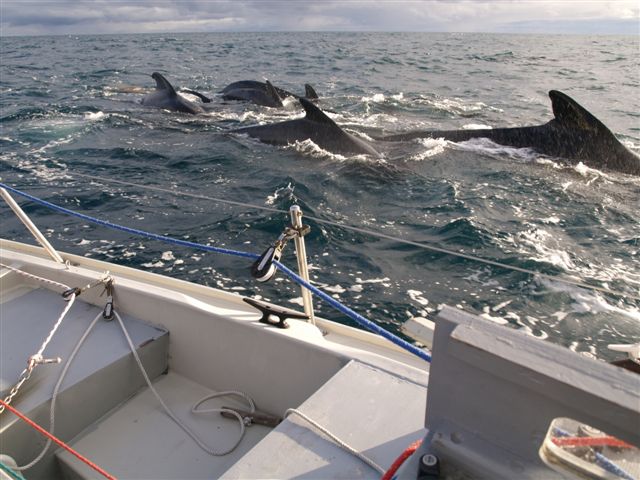 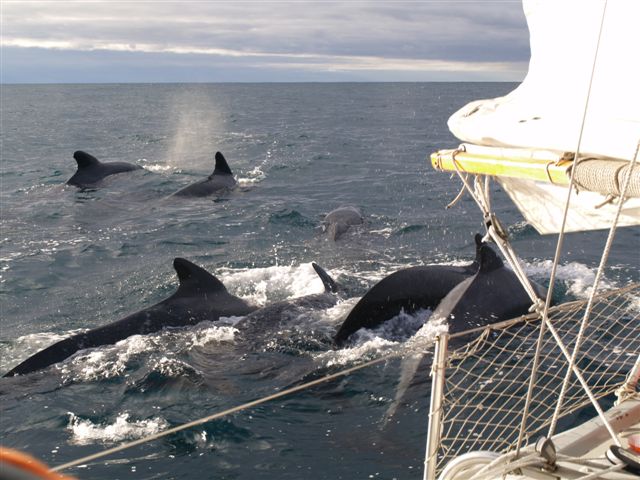 I thought they would soon be gone, bored by our slow pace. I was wrong. For the next five or six hours, well into the pale depths of the sub-arctic night, these two hundred or so long-finned pilot whales adopted Mingming and made her the centrepiece of their extraordinary cavortings. I say two hundred or so. That's my best guess. Try counting them. The ones you can see aren't there for long., certainly not long enough to count when there may be forty or fifty breaking the surface at one time. That leaves the rest. The ones beneath the surface. How do you count them? Not until they too surface to breathe, by which time the others have gone. Impossible. It was only by watching them hour after hour and by getting a sense of the rhythm of their surfacing and diving that I was eventually sure that there were between two hundred and two hundred and fifty. The big ones were big. Very big when they crowded alongside Mingming's hull. Eighteen to twenty feet long was my estimate. Of course many were much smaller. This was a great clan, a community, from toddlers to grandparents. The smallest, always tucked in close to a parental side, were about four feet in length. Youngsters age-wise maybe, but not in capacity. They swam as easily and as fluently and as fast as the adults. 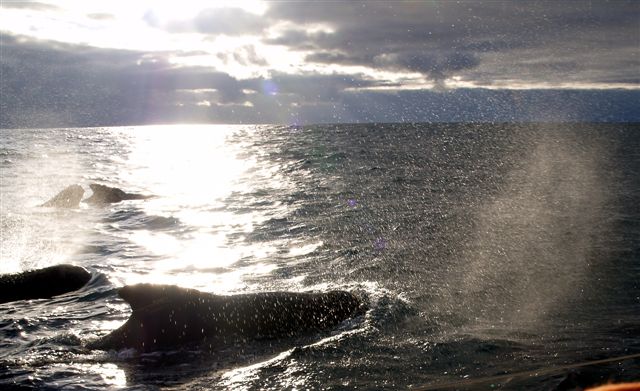 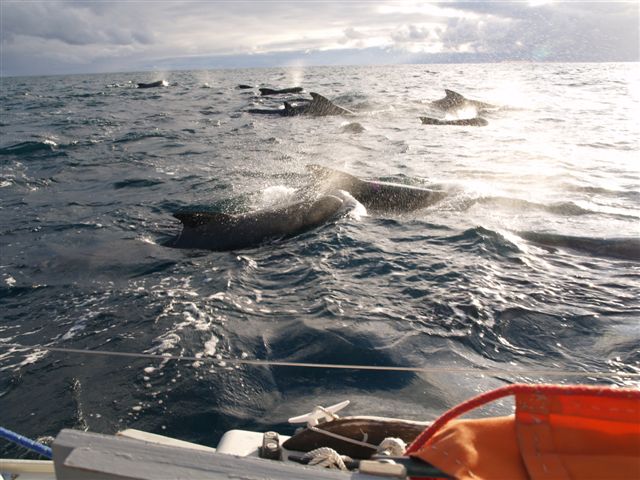 I made another guess, this time as to the whales' average weight. Probably close to 2000lbs. The big adults, with their swollen submarine-like forebodies and ten or twelve feet of sleek tail, all pure muscle, could well weigh twice that. Some quick maths suggested that there was at least two hundred tons worth of raw animal power hemming us in. They came closer and closer. Amidships Mingming has little more than twelve inches freeboard. I could easily have reached out and touched the fin or sides of one surfacing alongside. They were packed in tightly on each side, always heading the same way as Mingming, though she was scarcely moving. The strange thing was that as scores of whales made their endless passes along one side or the other, we seemed to be hurtling along with them. I longed for some wind, to really get moving and leap along too with these magnificent creatures. From time to time a bigger one would stand on its head, as it were, and swat its fluke at us, sending clouds of spray over the boat. The bow seemed to be the favourite spot for this. This tail flicking had the air of a challenge, a provocation. Only once were we actually slapped on the side. The whales, for all their speed and bulk and crowding, never touched or jostled us. Their constant exhalations suffused the air with a fine heavily-scented vapour. Not Chanel No. 5. Oh no. Grimsby No. 1, more like. They were breathing the fishy depths all over us, covering my hat and gloves and jacket with a noisome film. The pungent smell lingered for days. I didn't care. This was what I had come to sea for. To see the sea. To feel it and smell it and, if lucky, to garner from time to time a glimpse, a hint, of its strangeness. Now, after eighteen days, battling slowly north from the now-distant Essex coast, I had the reward that made it all worthwhile: two hundred tons of perfectly honed marine mammal giving a spectacle few would be privileged to see. As time went on I felt increasingly overwhelmed by the power of the experience. The incessant noise, the seemingly inexhaustible movement and energy of the whales, the fish-stench of their breath, the glistening black domes of their foreheads, their musculature, their athleticism, their sheer evolutionary perfection, was almost too much to take in. It was as if the sea had been turned upside down and inside out, laid bare before me. 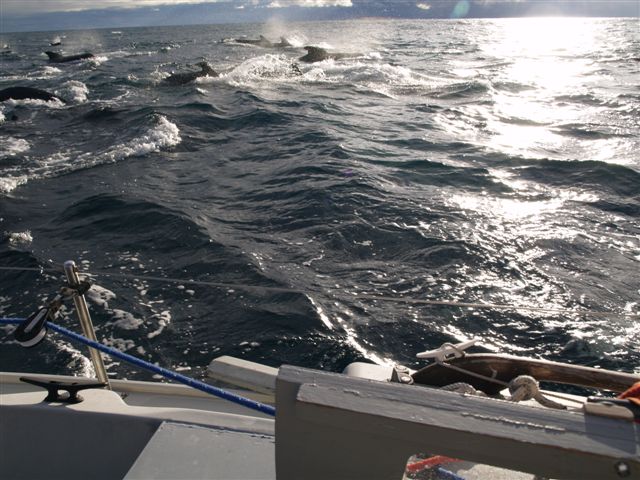 The wind died. Mingming lay motionless, but the whales kept up their relentless presence, circling and circling. For the first time, perhaps because I was now tired after hours of watching, photographing and filming, I became slightly anxious. There was more tail slapping, more seeming aggression. I knew full well that one of those foreheads could stove in Mingming's sides with ease. I tried to work out why they had clung to us for so long, but how can you? Curiosity? Boredom? Threat? In any case, who's to say that creatures like these need any motivation or behavioural rationale? Maybe they just do things because that's what they do. A pale midnight arrived and the whales' behaviour altered subtly. Their energy levels fell off. Some went into a sort of sleep mode, their front half laying flat, half out of the water, dorsal fin drooping down. Others stood vertically, the front few feet of their bodies straight out of the water, and observed us intently with a tiny eye. Just the one. The other eye, set so far apart on the other beam, as it were, looks quite in the other direction. What did they make of this strange invader? Could they distinguish between the inanimate form of the hull and sail, and the animate head, shoulders and arms protruding through the hatch? Did they see my eyes and look into them and recognise a fellow mammal? Perhaps if I could have interpreted their whistlings and trills I may have had an answer, for they talked to each other incessantly. At times they were audible from the hatch, but the place to eavesdrop was below decks. For once the annoying acoustical properties of the fibreglass hull, so hard-edged and brittle compared to wood, worked to advantage. The whales' radiophonic warblings came through loud and clear. The delicate cadences were somehow incongruous, coming as they did from these muscle-bound killing machines. Ethereal blackbird-like phrases repeated themselves, mingling into an endless counterpoint. Mingming's hull had become a big ear, a submarine listening device. I sat there for long periods, entranced by this haunting music, and tried to imprint the pitch and intonation of their whistlings onto my own inner ear. I can't whistle very well, but I managed to create a reasonable imitation that helped to register the sound permanently. The whales became less and less active, and so did I. I fell asleep. My inner watch-keeping clock woke me regularly throught the short half-night. Whenever I looked out fins still circled us, in ever smaller numbers. By dawn they were gone. 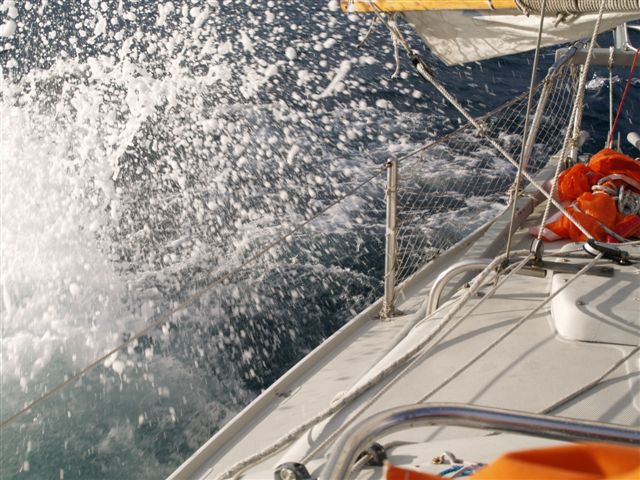 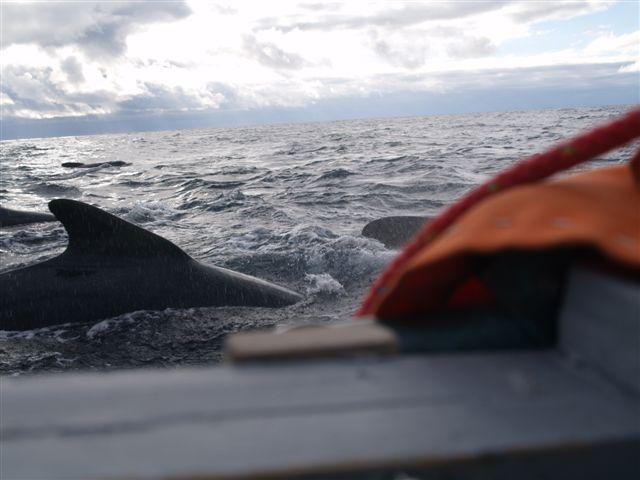 It was an extraordinary experience that left me numb for several days, overwhelmed by the impressions and questions it all raised. But I was euphoric. Whatever else did or did not happen,my voyage had been worthwhile. I had bagged a priceless encounter that could only be made in a small boat in distant waters. Ten days later we were six hundred miles to the south west. We had sighted the great Oraefajokull glacier on the south coast of Iceland, then headed south, passing to the west of Rockall. We were now a hundred and thirty miles west of Ireland, well on our way home. It was six in the morning and I lay half-dozing on my bunk. Once more the familiar puffs of cetaceans exhaling brought me to the hatch. I was stunned. Once more we were the centrepiece of a growing army of pilot whales. As before, new recruits were piling in from astern. As before, a small number of Atlantic white-sided dolphins kept to the flanks. As before, the numbers swelled to at least two hundred. As before, they pressed in close for five or six hours. But this time we had wind and were romping south on a fresh north easterly. This time we had magnificent light as the sun rose above the Irish hills somewhere below the eastern horizon. The photographs I had taken in the weak northern twilight had turned out duds. Now I could make amends. The whales to port were backlit, making dramatic effects, particularly of their vapour clouds. Those to starboard were bathed in a crisp light. In these conditions I could now see the whales clearly below the surface. I learned to watch them as they cruised effortlessly a few feet down and spot any imminent surfacing. This time my shots got better. The whales surface and breathe and dive again so fast that you have to anticipate by a fraction of a second to capture properly their heads well above the surface. This time we were making three or four knots. The whales could now at least get into first gear. They did not have to be quite so polite, shepherding us like and elderly and infirm aunt. This time we could really get going. It was exhilarating in the extreme to be at the centre of this leaping vanguard, stretching out a good half-mile on each flank. Whether we were mascot, prisoner-of-war, or adopted general for the day is impossible to say, but I felt we were at any rate part of some great and monumental enterprise as the legions surged forward. 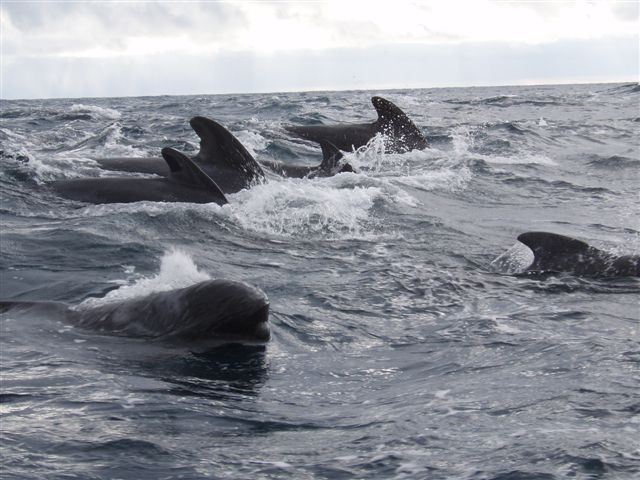 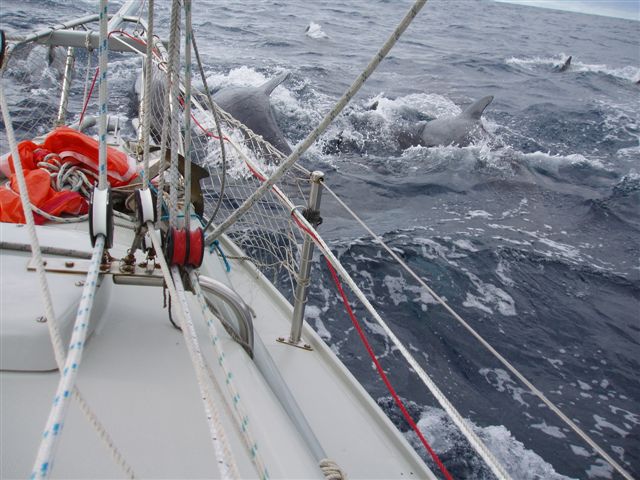 This was without doubt a different pod, although its behaviour was so similar to the first that the whales felt like old friends, come to rejoin us for a second time. I later learned that surveys had calculated that the north east Atlantic population of long-finned pilot whales - globicephala melas, and technically a species of dolphin - approaches 800,000. Thankfully, and despite the annual Faroese orgy of killing, they are not considered to be under threat. These are amazing creatures. They can live for over half a century. They live in large, more or less permanent groupings with a strong family and social structure. They are fiercely loyal to each other.This is why, if the lead whale, the 'pilot' they follow, makes an error and strands, the rest of the pod will strand too. It is more or less impossible to lead a part of a pod to safety. They will return to their stranded leader and an inevitable death. Their physical capacities are extraordinary. The adult males can weigh well over two tons. When they sound properly, to feed on the squid that is their main diet, they can dive to over eight hundred metres and stay down for nearly twenty minutes. Yet most of their time is spent patrolling the surface, at the interface between the cold depths and the world as we know it. Although by no means the fastest of the cetaceans, they are still prodigously athletic. I saw several leap quite clear of the water, re-entering with a monumental splash. 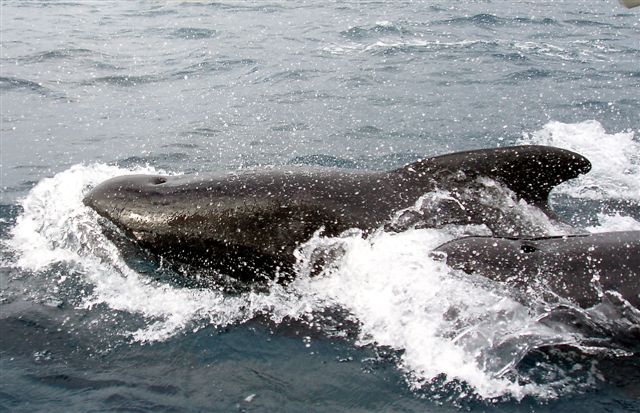 They are not under threat but, like so many inhabitants of the sea, their bodies are absorbing growing quantities of pollutants. The high levels of chemicals such as DDT and heavy metals like cadmium and mercury in their flesh has raised questions as to whether they are safe to eat. Well, I for one would be quite happy for them not to be eaten. A greater concern may be the effect of slow poisoning on their reproductive systems. As I enjoyed my time in amongst the second pod of visitors, I knew and cared little about the science. The overpowering presence and physicality of the whales ensured the experience was lived only at the level of sensation. At that moment my reaction was purely visceral. I just watched and listened, memerised by the speed and rhythms of their movements and the percussion of their explosive breathing. 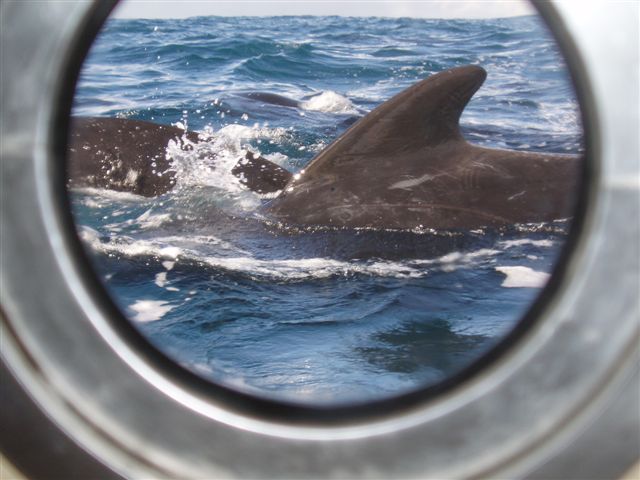 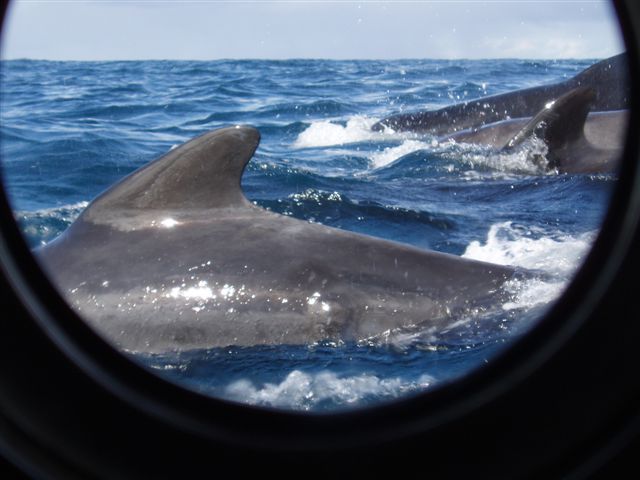 Eventually, after a whole morning spent with us, they gradually fell away until we were once more alone. As we made our way slowly south I reflected again on how alien the sea really is to us, how ill-equipped we are for it. We build our boats, big and small, and we find a thousand strategies to cross the oceans. We sometimes even delude ourselves that we have got the measure of the sea. But it is no longer our medium. We abandonned it many millions of years ago and only ever return to it as temporary, awkward strangers. The twelve hours or so spent with whales on this voyage had shown what mastery of the ocean really was. It was a vivid reminder of our own limitations. I resolved to remember always the images of those magnificent creatures, so fluent and at ease. I resolved to remind myself always that the sea is not my medium and to approach it always with the greatest respect and the deepest humility. 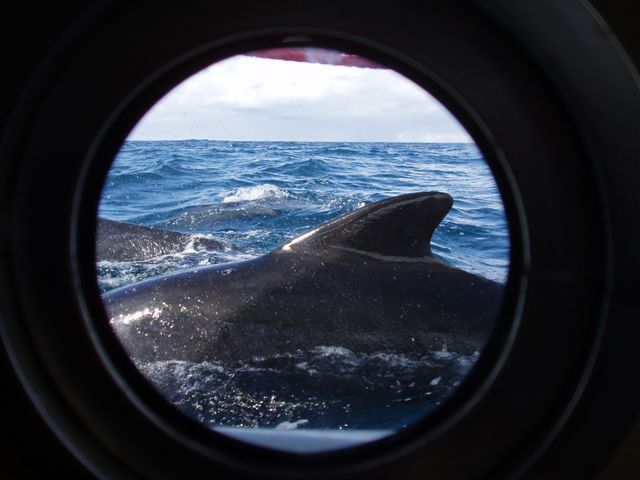 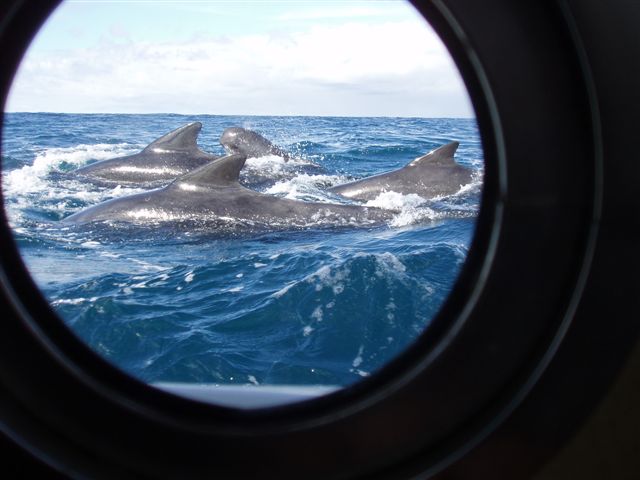 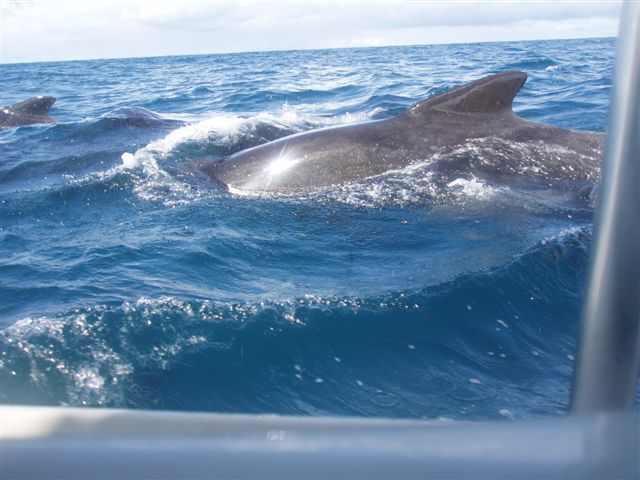 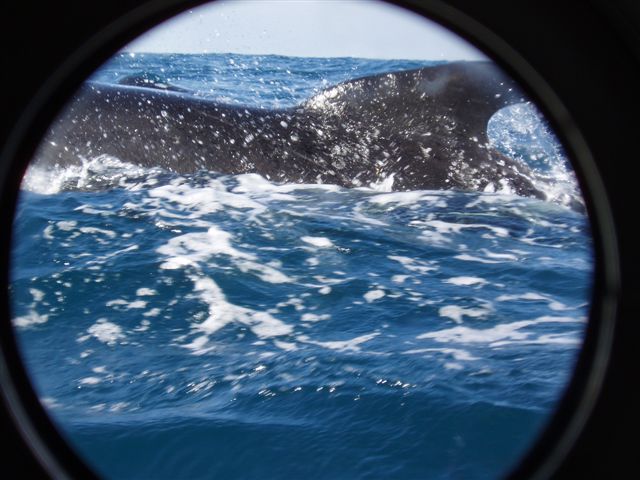 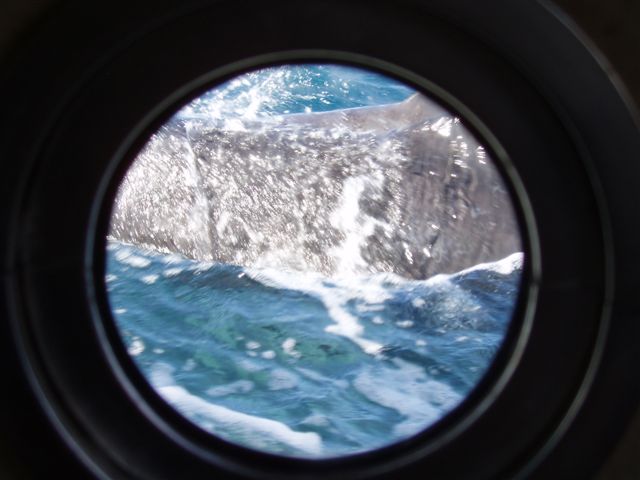 September 2007 |